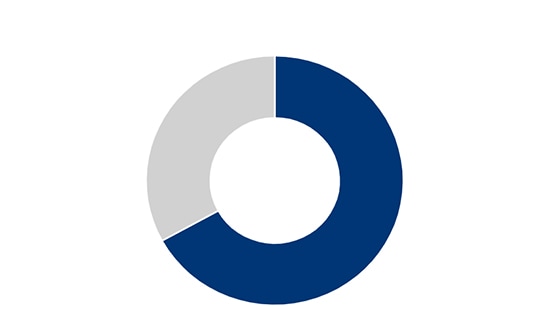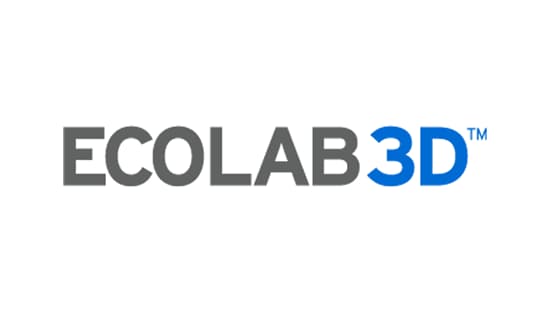Ocena stanu zarządzania zasobami wodnymi w erze opartej na sztucznej inteligencji
Świat doświadcza zwiększonego zapotrzebowania na energię i wodę, napędzanego głównie przez technologie transformacyjne, takie jak sztuczna inteligencja, a także ekstremalne zjawiska pogodowe i rozwijającą się gospodarkę.
- Szacuje się, że do 2030 r. wzrost związany ze sztuczną inteligencją będzie wymagał dodatkowej energii odpowiadającej rocznemu zapotrzebowaniu Indii1 i takiej samej ilości wody, aby zaspokoić roczne zapotrzebowanie na wodę pitną Stanów Zjednoczonych2.
- Do roku 20273 centra danych mogą zużywać ponad 1 bilionów galonów słodkiej wody rocznie.
- Przewiduje się, że do 20304 r. luka między podażą słodkiej wody a zapotrzebowaniem na nią wyniesie 56%, a do 20505 r. zapotrzebowanie na wodę wzrośnie nawet o 30%.
Ecolab jako globalny lider zrównoważonego rozwoju pomaga rozwiązywać te problemy związane z wodą. Nasze badania z 2025 r. dostarczają informacji na temat najnowszych spostrzeżeń i obaw związanych z wodą, co pomaga firmom, rządom i organizacjom non-profit w opracowywaniu skutecznych strategii dotyczących wody. Zrozumienie percepcji społecznej jest niezbędne, aby pomóc w informowaniu o tych strategiach i czynieniu postępów w kierunku przyszłości bezpiecznej pod względem wodnym.
Kluczowe wnioski z badania Ecolab Watermark z 2025 r.
Woda: ukryte koszty i możliwości związane ze sztuczną inteligencją
Podczas gdy wielu konsumentów zdaje sobie sprawę ze znacznego zużycia energii przez sztuczną inteligencję, niewielu zdaje sobie sprawę z jej znacznego śladu wodnego. Ta luka w świadomości jest szczególnie zauważalna w regionie Azji i Pacyfiku, regionie IMEA i Ameryce Łacińskiej.
Postrzeganie przez konsumentów zakresu, w jakim każdy zasób jest obecnie wykorzystywany do wspierania operacji związanych ze sztuczną inteligencją :

Chiny
81% mocy
77% wody

IMEA (Indie, Bliski Wschód i Afryka)
78% mocy
61% Wody

Ameryka Łacińska
68% mocy
51% Wody

Azja i Pacyfik
60% mocy
43% Wody

Europa
59% mocy
46% Wody

Stany Zjednoczone
55% mocy
46% Wody
Dane ilustrują wartości procentowe zgodności:
Firmy powinny wykorzystywać sztuczną inteligencję:
na rzecz odpowiedzialnego korzystania z zasobów naturalnych
Zaufanie firmom, że odpowiedzialnie zarządzają zapotrzebowaniem na energię w działaniach AI

IMEA (Indie, Bliski Wschód i Afryka)
2026
76%
63%

Chiny
2026
72%
77%

Ameryka Łacińska
70%
49%

Europa
2026
54%
37%

Azja i Pacyfik
51%
37%

Stany Zjednoczone
49%
39%

Inteligentna gospodarka wodna: konsumenci chcą, aby firmy ponownie wykorzystywały wodę w inteligentny sposób
Pomimo powszechnego przekonania konsumentów, że firmy powinny priorytetowo traktować inteligentną gospodarkę wodną w celu rozwiązania problemu niedoboru wody, mniej osób uważa, że firmy te z powodzeniem wdrażają rozwiązania dotyczące ponownego wykorzystania wody.
Odsetek konsumentów , którzy uważają, że firmy ograniczają zużycie wody, ponownie ją wykorzystują, poddają recyklingowi, przywracają i odzyskują w całej swojej codziennej działalności.

Stany Zjednoczone
43%

Europa
44%

Ameryka Łacińska
48%

Azja i Pacyfik
48%

IMEA (Indie, Bliski Wschód i Afryka)
67%

Chiny
74%
Wśród konsumentów na całym świecie panuje powszechna zgoda co do tego, że:
Przedsiębiorstwa muszą obrać za priorytet inwestycje w technologie i infrastrukturę, aby zwiększyć odporność zasobów wodnych.
aby ochraniać zasoby wodne przed zmianami klimatu:

Ameryka Łacińska
84%
85%

IMEA (Indie, Bliski Wschód i Afryka)
2026
82%
82%

Chiny
2026
77%
76%

Europa
2026
72%
71%

Azja i Pacyfik
71%
70%

Stany Zjednoczone
68%
67%
Firmy wykazujące się odpowiedzialnymi praktykami związanymi z gospodarką wodną mogą spodziewać się dużego zainteresowania ze strony konsumentów.
Odsetek konsumentów skłonnych do
aktywnego szukania więcej informacji
od tych firm:

Ameryka Łacińska
82%

IMEA (Indie, Bliski Wschód i Afryka)
2026
78%

Chiny
2026
68%

Azja i Pacyfik
61%

Europa
2026
61%

Stany Zjednoczone
61%
Partnerstwa wodne
Żaden pojedynczy podmiot nie jest w stanie samodzielnie sprostać wyzwaniom związanym z wodą. Nawiązując silne współprace, firmy, rządy i społeczności mogą przyspieszyć skoordynowane działania, stworzyć rozwiązania i zbudować zabespieczoną pod względem wody przyszłość dla wszystkich.
W większości regionów konsumenci uważają, że to przedsiębiorstwa (w tym producenci)) oraz rządy są odpowiedzialni w podobnym stopniu za oszczędzanie wody. Jednak nadal spotykają się z krytyką za niewystarczający wkład w porównaniu z osobami fizycznymi, organizacjami non-profit i organizacjami zajmującymi się ochroną przyrody.
Poniższe dane szczegółowo opisują postrzeganie przez konsumentów tego, ile każdy podmiot zrobił do tej pory, aby oszczędzać wodę w swoim kraju:

Ameryka Łacińska
42% biznesy
55% osoby
48% Rząd
60% organizacje non-profit

Europa
2026
45% biznesy
56% osoby
45% Rząd
54% organizacje non-profit

Stany Zjednoczone
47% biznesy
58% osoby
48% Rząd
56% organizacje non-profit

Azja i Pacyfik
2026
48% biznesy
49% osoby
46% Rząd
50% organizacje non-profit

IMEA (Indie, Bliski Wschód i Afryka)
2026
63% biznesy
69% osoby
79% Rząd
67% organizacje non-profit

Chiny
2026
80% biznesy
79% osoby
84% Rząd
79% organizacje non-profit
Pomimo globalnych wyzwań związanych z wodą, konsumenci z dużym optymizmem podchodzą do naszej zdolności do sprostania tym wyzwaniom.
Zdecydowana większość - ponad 60% konsumentów w każdym regionie - uważa, że niedobór wody
można rozwiązać w skuteczny sposób.
Stopień, w jakim konsumenci
zgadzają się, że niedobór wody
można skutecznie rozwiązać:

Ameryka Łacińska
84%

IMEA (Indie, Bliski Wschód i Afryka)
2026
83%

Chiny
2026
73%

Stany Zjednoczone
67%

Europa
2026
66%

Azja i Pacyfik
61%
Ekstremalne zjawiska pogodowe
Konsumenci dostrzegają, że zmiany pogody i wzrost liczby klęsk żywiołowych nasilają deficyty wody,
co prowadzi do wyzwań zarówno w zakresie dostępności, jak i jakości wody.
Odsetek konsumentów, którzy łączą zmiany klimatyczne z nasilającym się deficytem wody:

IMEA (Indie, Bliski Wschód i Afryka)
2026
81%

Chiny
2026
80%

Ameryka Łacińska
79%

Azja i Pacyfik
2026
69%

Europa
2026
69%

Stany Zjednoczone
65%
Konsumenci wyraźnie domagają się podjęcia działań w sprawie zmian klimatycznych oraz stawiają im wysokie oczekiwania
zarówno w zakresie przywództwa korporacyjnego, jak i rządowego.
Odsetek konsumentów, którzy uważają, że
bardzo ważne jest, aby rządy, oraz firmy objęły za priorytet wysiłki mające na celu zmniejszenie
wpływu zmian klimatu:

Ameryka Łacińska
87%
88%

IMEA (Indie, Bliski Wschód i Afryka)
2026
81%
81%

Chiny
2026
76%
77%

Europa
2026
71%
71%

Azja i Pacyfik
70%
69%

Stany Zjednoczone
67%
67%
Godne uwagi trendy roczne
Ponieważ dostęp do czystej i bezpiecznej wody nadal jest krytyczną kwestią globalną, poziom obaw konsumentów jest godny uwagi.
Jak bardzo konsumenci boją się o czystą i bezpieczną wodę z podziałem na regiony:

Chiny
2026
96%

Ameryka Łacińska
92%

Stany Zjednoczone

Europa
2026
69%

IMEA (Indie, Bliski Wschód i Afryka)
2026
67%

Azja i Pacyfik
2026
63%
Konsumenci w większości regionów konsekwentnie identyfikują rolnictwo i
przemysł spożywczy jako branże najbardziej odpowiedzialne za zużycie wody.
rolnictwo
Przemysł spożywczy

IMEA (Indie, Bliski Wschód i Afryka)
2026
52%
37%

Ameryka Łacińska
48%
44%

Azja i Pacyfik
47%
36%

Europa
2026
47%
33%

Stany Zjednoczone
43%
31%

Chiny
2026
29%
28%
Ulepszanie zarządzania zasobami wodnymi
Od ponad 100 lat Ecolab pracuje nad ochroną zasobów niezbędnych do życia, stawiając na pierwszym miejscu zarządzanie zasobami wodnymi we własnych działaniach i działaniach naszych klientów. Ecolab pomaga firmom w ponad 40 branżach na całym świecie reagować na wyzwania związane z klimatem i wodą, minimalizując zużycie wody w kluczowych procesach. Pomagamy naszym klientom wywierać trwały wpływ oraz osiągać wykładniczy zwrot z inwestycji (eROI) poprzez dostosowanie celów związanych z klimatem, wodą i rozwojem biznesu.
Nasze rozwiązania
Zarządzając ponad bilionem galonów wody rocznie, Ecolab łączy Connected Chemistry™
z cyfrową wiedzą i doświadczeniem branżowym, aby napędzać zrównoważony rozwój i wzrost.
Dowiedz się więcej o tym, jak Ecolab może pomóc z inteligentną gospodarką wodną w Twojej działalności.

Rozpoznanie możliwości za pomocą aplikacji Smart Water Navigator

Korporacyjne podejście z Ecolab Water for Climate™

Zarządzanie gospodarką wodną z technologią 3D TRASAR™

Wizualizacja informacji z usługami cyfrowymi ECOLAB3D™
Nasze projekty
Kiedy zajmiesz się odpornością zasobów wodnych, biznes może się rozwijać. Poniższe studia przypadków pokazują, w jaki sposób Ecolab pomaga wywierać pozytywny wpływ na cele naszych klientów związane z biznesem, wodą oraz klimatem:
Nasze partnerstwa
Współpraca z wiodącymi organizacjami pozarządowymi (NGO) pozwala nam pogłębić zrozumienie i wzmocnić zdolność wpływania na globalne wyzwania, przed którymi stoi nasza działalność, klienci i społeczności. Zawierają one:
- Bloomberg Law, „AI Computing on Pace to Consume More Energy Than India, Arm Says", kwiecień 2024: news.bloomberglaw.com/artificial-intelligence/ai-computing-on-pace-to-consume-more-energy-than-india-arm-says↵
- Analiza Ecolab danych pochodzących od Lei, N., & Masanet, E. (2022) oraz Goldman Sachs (2024)↵
- Making AI Less “Thirsty”: Uncovering and Addressing the Secret Water Footprint of AI Models: www.goldmansachs.com/insights/articles/AI-poised-to-drive-160-increase-in-power-demand and TIME, “How AI Is Fueling a Boom in Data Centers and Energy Demand”: time.com/6987773/ai-data-centers-energy-usage-climate-change/↵
- World Resource Institute: “Setting Enterprise Targets: Modeling Downstream Water Use and Consumption”: Setting Enterprise Targets: Modeling Downstream Water Use and Consumption | World Resource Institute↵
- World Resource Institute, “Securing Freshwater for All”: www.wri.org/freshwater↵


